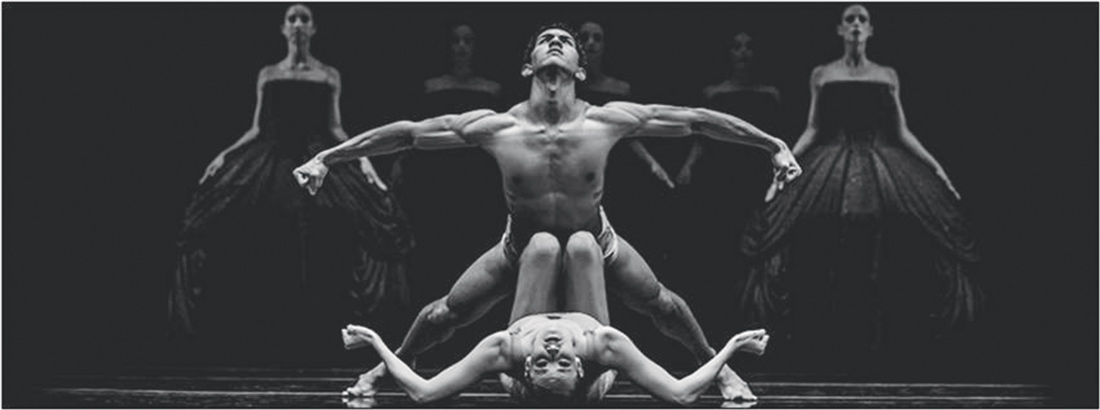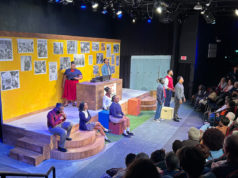Repertory programs showcasing three or four short ballets, with a pas de deux thrown in sometimes for spice, have been the savior of small companies for decades. Little or no scenery and simple costumes keep production costs low. Many of the ballets appear on a bare stage with dancers in leotards, t-shirts, and tights.
Such was the case last weekend in Bass Performance Hall, when Texas Ballet Theater presented Artistic Director’s Choice. The artistic director in question is Ben Stevenson, who has been at the helm for nearly a decade after a long tenure at the Houston Ballet, where he accumulated a veritable warehouse stacked with full-length story ballets. But once a season, TBT presents a program of short works and last week offered one of its finest.
The first two offerings –– the Fort Worth debut of Czech choreographer Jiri Kylian’s Petite Mort from 1991 and the world premiere of Jonathan Watkins’ Crash –– featured women in flesh-colored leotards and men in flesh-colored shorts. There were a lot of other similarities, so many that I was surprised to see the two ballets on the same program. For me, it took something away from the Watkins ballet.
The opening of Petite Mort consisted of several minutes of silence on a darkened stage. Six male dancers holding fencing foils moved in unison into various positions until what sounded like a growing wind storm reached a climax and the gentle sounds of the slow movement of Mozart’s Concerto No. 23 began to fill the hall. (All sound for the program was prerecorded.)
Six women appeared out of the shadows upstage and began to dance with the men. The ballet’s title loosely translates into “little death,” an old French euphemism for “orgasm,” but I saw nothing sexual, or even erotic, in the encounters. There was a brief sequence in which the ballerinas were on the floor on their backs as the male dancers hovered above, but the men looked more like they were getting ready to do pushups than have sex. No suggestive move was made, and the moment was gone.
The dancers then disappeared in the darkness upstage, and the ballerinas returned in black strapless ball gowns with fitted bodices and full net skirts. They glided from one side of the stage to the other in magical-looking movements. Suddenly, the women stopped and stepped back –– but the gowns stayed put. They were artificial props on wheels, a bit of whimsy that was delightful and charming.
No extended solos dotted the ballet, but a few brief duos were included. In one of them, Carolyn Judson and Simon Wexler were wonderfully engaging.
Kylian’s choreographic style here was a captivating mix of classical and modern that didn’t offend Mozart’s soothing music. Traditional lifts ended up with unusual flourishes. Movements were strong and often original, and there were no rough edges. He even acknowledged the little decorative turns and trills at the end of a Mozart phrase with a ballerina quickly pumping her feet to the rhythm.
Watkins used much of the same choreographic vocabulary for his piece and also a loud crescendo at the beginning. His explosion, or crash, an emotional breakdown over some misfortune, was followed by a slow return to normal. His full cast gravitated to the center of the stage as the music got louder. Surrounded by darkness, the dancers thrashed and flailed their arms until the music suddenly stopped and the lights went out. They returned slowly to the stage, the men now wearing black t-shirts and shorts, the women also in black. Gradually, the tempo picked up, and the movements became more animated. Tony Tucci did a terrific job with the atmospheric lighting.
The accompanying music, composed by Dallas’ Ryan Cockerham, was quasi-minimalist. Unlike most minimalist music, however, his score didn’t hammer you over the head with repetitive phrases. And the sound, produced primarily from piano and violin, was pleasant, almost romantic at times.
Again there were no expanded solos here, although Leticia Oliveira managed a triple –– possibly a quadruple; I lost count –– series of turns: stationary on pointe, straight up, no wobble. The audience exploded in spontaneous applause.
The evening closed with a bright flourish, courtesy of George Balanchine’s exuberant “Rubies” from his 1967 ballet Jewels. After the subdued lighting of the earlier ballets, the brilliantly lit white backdrop and vivid red costumes were a welcome eye opener.
Set to the 1929 version of Igor Stravinsky’s Capriccio for piano and orchestra, “Rubies” is a tightly knit ensemble piece that tests the skills of any company. TBT –– especially Oliveira and Wexler as the principal couple –– acquitted themselves remarkably well during Saturday night’s performance.
TBT opens next season in September with Stevenson’s Dracula at the Winspear Opera House with the Dallas Symphony Orchestra in the pit, a first for TBT. The company will then bring the ballet to Bass Hall to be accompanied by the Fort Worth Symphony Orchestra.












